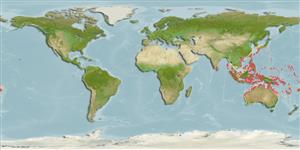Classification / Names
ชื่อสามัญ | ชื่อพ้อง | Catalog of Fishes(สกุล, ชนิด) | ITIS | CoL | WoRMS | Cloffa
>
Ophidiiformes (Cusk eels) >
Dinematichthyidae (Viviparous brotula)
Etymology: Alionematichthys: Name from Latin alius meaning the other or different, and nematichthys, the stem of the genus name Dinematichthys, to which this genus is most similar.
Environment: milieu / climate zone / depth range / distribution range
นิเวศวิทยา
เกี่ยวกับทะเล,น้ำเค็ม เกี่ยวกับหินโสโครก; ระดับความลึก 0 - 10 m (Ref. 90102). Tropical
Western Pacific: Ryukyu Islands, Fiji and eastern Australia. More recently reported from Ouvéa Atoll, Loyalty Islands (Ref. 13236).
ขนาด / น้ำหนัก / Age
Maturity: Lm ? range ? - ? cm
Max length : 7.9 cm SL เพศผู้/กระเทย; (Ref. 13278)
Short description
เครื่องมือที่ใช้ในการแยกชนิดสัตว์,สิ่งมีชีวิตออกจากกัน | สัณฐานวิทยา | ความยาวต่างๆ
เงี่ยงครีบหลัง (รวม) : 0; ก้านครีบอ่อนที่หาง (รวม) : 77 - 92; ก้านครีบอ่อนที่ก้น: 59 - 72; สัตว์มีกระดูกสันหลัง: 41 - 44. This species is distinguished by the following characters: D 77-92; A 59-72; moderately large eyes (2.5-3.0% SL); moderately slender, massive body, snout with many cirri; cheeks with scales and a large scale patch on opercular spine(6-17), with large specimens having a few scales below opercular spine; with upper preopercular pore; outer pseudoclasper broad-based, not very large, not extending beyond hood in resting position; the inner pseudoclasper is not much smaller than the outer one, equal anterior and posterior lobes, anterior lobe broadly connected to anterior rim of outer pseudoclasper; slender otolith, its length to height 2.2-2.4, with gently curved dorsal rim; otolith length to sulcus length 1.6-1.7, ostium length to caudal length 3.5-4.0; vertebrae 11-12 + 30-32 = 41-44 (Ref. 81230).
Uncommon species (Ref. 34024), inhabiting coral reefs (Ref. 13278). Cryptic, solitary inhabitant of shallow water (<10 m) (Ref 90102).
Life cycle and mating behavior
วัยเจริญพันธุ์ | การสืบพันธุ์ | การวางไข่ | เซลสืบพันธ์ของเพศเมีย(ไข่) | ความดกของไข่ | ตัวอ่อน
Nielsen, J.G., D.M. Cohen, D.F. Markle and C.R. Robins, 1999. Ophidiiform fishes of the world (Order Ophidiiformes). An annotated and illustrated catalogue of pearlfishes, cusk-eels, brotulas and other ophidiiform fishes known to date. FAO Fish. Synop. 125(18):178p. Rome: FAO. (Ref. 34024)
IUCN Red List Status (Ref. 130435: Version 2024-2)
Threat to humans
Harmless
Human uses
การประมง: ไม่มีผลประโยชน์
เครื่องมือ
Special reports
Download XML
แหล่งที่มาจากอินเตอร์เน็ต
Estimates based on models
Preferred temperature (Ref.
123201): 24.9 - 29.3, mean 28.6 °C (based on 2261 cells).
Phylogenetic diversity index (Ref.
82804): PD
50 = 0.5005 [Uniqueness, from 0.5 = low to 2.0 = high].
Bayesian length-weight: a=0.00389 (0.00180 - 0.00842), b=3.12 (2.94 - 3.30), in cm total length, based on all LWR estimates for this body shape (Ref.
93245).
ระดับชั้นอาหาร (Ref.
69278): 3.3 ±0.5 se; based on size and trophs of closest relatives
ความสามารถในการกลับคืนสู่ปกติ (Ref.
120179): ต่ำ, เวลาต่ำสุดที่จะทำให้ประชากรเพิ่มขึ้นเป็น 2 เท่าใช้เวลา 4.5 - 14 ปี (Assuming Fec < 100).
Fishing Vulnerability (Ref.
59153): Low vulnerability (10 of 100).
Nutrients (Ref.
124155): Calcium = 180 [97, 341] mg/100g; Iron = 0.98 [0.55, 1.71] mg/100g; Protein = 16.8 [14.2, 19.3] %; Omega3 = 0.105 [0.057, 0.192] g/100g; Selenium = 22.9 [10.9, 55.4] μg/100g; VitaminA = 124 [36, 419] μg/100g; Zinc = 2.59 [1.72, 3.72] mg/100g (wet weight);
